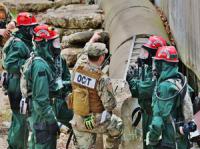-
Re-thinking Biological Arms Control for the 21st Century
International treaties prohibit the development and use of biological weapons. Yet concerns about these weapons have endured and are now escalating. Filippa Lentzos writes in a paper issued by the U.S. Marine Corps that a major source of the growing concern about future bioweapons threats stem from scientific and technical advances. Innovations in biotechnology are expanding the toolbox to modify genes and organisms at a staggering pace, making it easier to produce increasingly dangerous pathogens. Disease-causing organisms can now be modified to increase their virulence, expand their host range, increase their transmissibility, or enhance their resistance to therapeutic interventions. Scientific advances are also making it theoretically possible to create entirely novel biological weapons, by synthetically creating known or extinct pathogens or entirely new pathogens. Scientists could potentially enlarge the target of bioweapons from the immune system to the nervous system, genome, or microbiome, or they could weaponize ‘gene drives’ that would rapidly and cheaply spread harmful genes through animal and plant populations.
-
-
Largest-ever simulation of the Deepwater Horizon spill
In a 600-ft.-long saltwater wave tank on the coast of New Jersey, a team of NJIT researchers is conducting the largest-ever simulation of the Deepwater Horizon spill to determine more precisely where hundreds of thousands of gallons of oil dispersed following the drilling rig’s explosion in the Gulf of Mexico in 2010.
-
-
Global cybersecurity experts gather at Israel’s Cyber Week
The magnitude of Israel’s cybersecurity industry was on full show this week at the 9th Annual Cyber Week Conference at Tel Aviv University. The largest conference on cyber tech outside of the United States, Cyber Week saw 8,000 attendees from 80 countries hear from more than 400 speakers on more than 50 panels and sessions.
-
-
Any single hair from the human body can be used for identification
Any single hair from anywhere on the human body can be used to identify a person. This conclusion is one of the key findings from a nearly year-long study by a team of researchers. The study could provide an important new avenue of evidence for law enforcement authorities in sexual assault cases.
-
-
Rectifying a wrong nuclear fuel decision
In the old days, new members of Congress knew they had much to learn. They would defer to veteran lawmakers before sponsoring legislation. But in the Twitter era, the newly elected are instant experts. That is how Washington on 12 June witnessed the remarkable phenomenon of freshman Rep. Elaine Luria (D-Norfolk), successfully spearheading an amendment that may help Islamist radicals get nuclear weapons. The issue is whether the U.S. Navy should explore modifying the reactor fuel in its nuclear-powered vessels — as France already has done — to reduce the risk of nuclear material falling into the hands of terrorists such as al-Qaida or rogue states such as Iran. Luria says no. Alan J. Kuperman writes in the Pilot Online that more seasoned legislators have started to rectify the situation by passing a spending bill on 19 June that includes the funding for naval fuel research. They will have the chance to fully reverse Luria in July on the House floor by restoring the authorization. Doing so would not only promote U.S. national security but teach an important lesson that enthusiasm is no substitute for experience.
-
-
Deepfake detection algorithms will never be enough
You may have seen news stories last week about researchers developing tools that can detect deepfakes with greater than 90 percent accuracy. It’s comforting to think that with research like this, the harm caused by AI-generated fakes will be limited. Simply run your content through a deepfake detector and bang, the misinformation is gone! James Vincent writers in The Verge that software that can spot AI-manipulated videos, however, will only ever provide a partial fix to this problem, say experts. As with computer viruses or biological weapons, the threat from deepfakes is now a permanent feature on the landscape. And although it’s arguable whether or not deepfakes are a huge danger from a political perspective, they’re certainly damaging the lives of women here and now through the spread of fake nudes and pornography.
-
-
The history of cellular network security doesn’t bode well for 5G
There’s been quite a bit of media hype about the improvements 5G is set to supposedly bring to users, many of which are no more than telecom talking points. One aspect of the conversation that’s especially important to get right is whether or not 5G will bring much-needed security fixes to cell networks. Unfortunately, we will still need to be concerned about these issues—and more—in 5G.
-
-
Deepfakes: Forensic techniques to identify tampered videos
Computer scientists have developed a method that performs with 96 percent accuracy in identifying deepfakes when evaluated on large scale deepfake dataset.
-
-
AI helps protect emergency personnel in hazardous environments

Whether it’s at rescue and firefighting operations or deep-sea inspections, mobile robots finding their way around unknown situations with the help of artificial intelligence (AI) can effectively support people in carrying out activities in hazardous environments.
-
-
Geoengineer the planet? More scientists now say it must be an option

Once seen as spooky sci-fi, geoengineering to halt runaway climate change is now being looked at with growing urgency. A spate of dire scientific warnings that the world community can no longer delay major cuts in carbon emissions, coupled with a recent surge in atmospheric concentrations of CO2, has left a growing number of scientists saying that it’s time to give the controversial technologies a serious look. Fred Pearce writes in Yale Environment 360 that among the technologies being considered are a range of efforts to restrict solar radiation from reaching the lower atmosphere, including spraying aerosols of sulphate particles into the stratosphere, and refreezing rapidly warming parts of the polar regions by deploying tall ships to pump salt particles from the ocean into polar clouds to make them brighter.
-
-
Identifying a fake picture online is harder than you might think

Research has shown that manipulated images can distort viewers’ memory and even influence their decision-making. So the harm that can be done by fake images is real and significant. Our findings suggest that to reduce the potential harm of fake images, the most effective strategy is to offer more people experiences with online media and digital image editing – including by investing in education. Then they’ll know more about how to evaluate online images and be less likely to fall for a fake.
-
-
International community unprepared to deal with catastrophic biological event
The risks of a global catastrophic biological event are growing, intensified by an increasingly interconnected world, terrorist and state interest in weapons of mass destruction, global political instability, and rapid advances in biotechnology. International leaders and organizations today are unprepared to react with the kind of effective, coordinated response needed to investigate and identify the pathogen, prevent the spread of disease, and, most importantly, save lives.
-
-
“Vaccinating” algorithms against attacks on machine learning
Algorithms “learn” from the data they are trained on to create a machine learning model that can perform a given task effectively without needing specific instructions, such as making predictions or accurately classifying images and emails. Researchers have developed a world-first set of techniques to effectively “vaccinate” algorithms against adversarial attacks, a significant advancement in machine learning research.
-
-
Mass surveillance is coming to a city near you
The tech entrepreneur Ross McNutt wants to spend three years recording outdoor human movements in a major U.S. city, KMOX news radio reports. Conor Friedersdorf writes in The Atlantic that if that sounds too dystopian to be real, you’re behind the times. McNutt, who runs Persistent Surveillance Systems, was inspired by his stint in the Air Force tracking Iraqi insurgents. He tested mass-surveillance technology over Compton, California, in 2012. In 2016, the company flew over Baltimore, feeding information to police for months (without telling city leaders or residents) while demonstrating how the technology works to the FBI and Secret Service.
-
-
NIST updates to help defend sensitive information from cyberattack
An update to one of the National Institute of Standards and Technology’s (NIST) information security documents offers strategies to help protect sensitive information that is stored in computers supporting critical government programs and high value assets. The new companion publication offers enhanced security for information stored in critical programs and assets.
-
More headlines
The long view
Autonomous Vehicle Technology Vulnerable to Road Object Spoofing and Vanishing Attacks
Researchers have demonstrated the potentially hazardous vulnerabilities associated with the technology called LiDAR, or Light Detection and Ranging, many autonomous vehicles use to navigate streets, roads and highways. The researchers have shown how to use lasers to fool LiDAR into “seeing” objects that are not present and missing those that are – deficiencies that can cause unwarranted and unsafe braking or collisions.
Tantalizing Method to Study Cyberdeterrence
Tantalus is unlike most war games because it is experimental instead of experiential — the immersive game differs by overlapping scientific rigor and quantitative assessment methods with the experimental sciences, and experimental war gaming provides insightful data for real-world cyberattacks.
Prototype Self-Service Screening System Unveiled
TSA and DHS S&T unveiled a prototype checkpoint technology, the self-service screening system, at Harry Reid International Airport (LAS) in Las Vegas, NV. The aim is to provide a near self-sufficient passenger screening process while enabling passengers to directly receive on-person alarm information and allow for the passenger self-resolution of those alarms.
Falling Space Debris: How High Is the Risk I'll Get Hit?
An International Space Station battery fell back to Earth and, luckily, splashed down harmlessly in the Atlantic. Should we have worried? Space debris reenters our atmosphere every week.
Testing Cutting-Edge Counter-Drone Technology
Drones have many positive applications, bad actors can use them for nefarious purposes. Two recent field demonstrations brought government, academia, and industry together to evaluate innovative counter-unmanned aircraft systems.
Strengthening the Grid’s ‘Backbone’ with Hydropower
Argonne-led studies investigate how hydropower could help add more clean energy to the grid, how it generates value as grids add more renewable energy, and how liner technology can improve hydropower efficiency.
The Tech Apocalypse Panic is Driven by AI Boosters, Military Tacticians, and Movies
From popular films like a War Games or The Terminator to a U.S. State Department-commissioned report on the security risk of weaponized AI, there has been a tremendous amount of hand wringing and nervousness about how so-called artificial intelligence might end up destroying the world. There is one easy way to avoid a lot of this and prevent a self-inflicted doomsday: don’t give computers the capability to launch devastating weapons.
The Tech Apocalypse Panic is Driven by AI Boosters, Military Tacticians, and Movies
From popular films like a War Games or The Terminator to a U.S. State Department-commissioned report on the security risk of weaponized AI, there has been a tremendous amount of hand wringing and nervousness about how so-called artificial intelligence might end up destroying the world. There is one easy way to avoid a lot of this and prevent a self-inflicted doomsday: don’t give computers the capability to launch devastating weapons.
